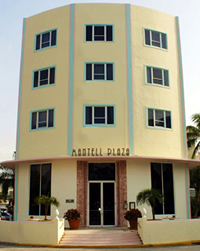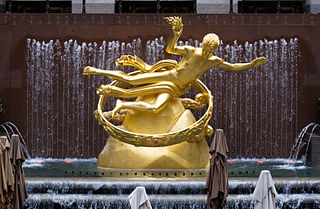This article includes a list of general references, but it lacks sufficient corresponding inline citations .(October 2022) |
This is a list of buildings that are examples of the Art Deco architectural style in Florida, United States.
This article includes a list of general references, but it lacks sufficient corresponding inline citations .(October 2022) |
This is a list of buildings that are examples of the Art Deco architectural style in Florida, United States.








Streamline Moderne is an international style of Art Deco architecture and design that emerged in the 1930s. Inspired by aerodynamic design, it emphasized curving forms, long horizontal lines, and sometimes nautical elements. In industrial design, it was used in railroad locomotives, telephones, toasters, buses, appliances, and other devices to give the impression of sleekness and modernity.

Albert Anis was an architect in Miami, Florida known for his Art Deco architecture. He was one of a group of American-born architects working in Miami Beach who synthesized the austere architectural principles of the International Style architecture with their own brand of modernism which embraced the ornamentation and exotic lure of the tropical.

The Miami Beach Architectural District is a U.S. historic district located in the South Beach neighborhood of Miami Beach, Florida. The area is well known as the district where Italian fashion designer Gianni Versace lived and was assassinated by Andrew Cunanan, in a mansion on Ocean Drive. It is bounded by the Atlantic Ocean to the east, Sixth Street to the south, Alton Road to the west and the Collins Canal and Dade Boulevard to the north. It contains 960 historic buildings.

Lawrence Murray Dixon was an architect in Miami Beach, Florida. He was born in Live Oak, Florida, attended the Georgia School of Technology (1918-1919) and worked in New York for Schultze and Weaver from 1923 to 1929 when he moved to Miami Beach. He is credited with designing The Temple House (1933) in the South Beach section of Miami Beach as well as other Art Deco hotels and residences. Dixon is listed as a Great Floridian.
Henry Hohauser was an architect in Miami Beach, Florida. He is known for his Art Deco architecture stylings, and is listed as a "Great Floridian"; in 1993, he was ranked as one of the 100 most influential people in South Florida history by The Miami Herald.

The Art Deco style, which originated in France just before World War I, had an important impact on architecture and design in the United States in the 1920s and 1930s. The most notable examples are the skyscrapers of New York City, including the Empire State Building, Chrysler Building, and Rockefeller Center. It combined modern aesthetics, fine craftsmanship, and expensive materials, and became the symbol of luxury and modernity. While rarely used in residences, it was frequently used for office buildings, government buildings, train stations, movie theaters, diners and department stores. It also was frequently used in furniture, and in the design of automobiles, ocean liners, and everyday objects such as toasters and radio sets.